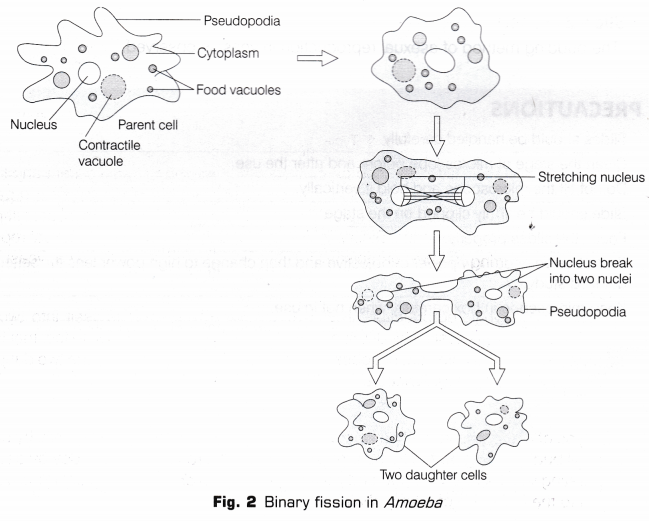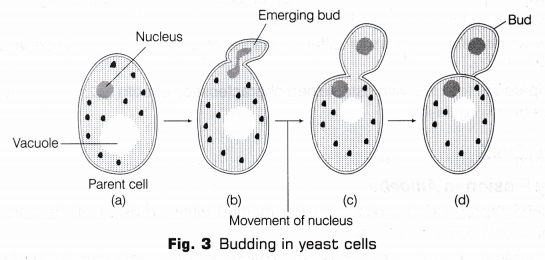CBSE Class 10 Science Lab Manual – Binary Fission in Amoeba and Budding in Yeast
Aim
To study binary fission in Amoeba and budding in yeast with the help of prepared permanent slides.
Materials Required
Permanent slides showing binary fission in Amoeba and budding in yeast, charts of binary fission and budding and a compound microscope.
Theory/Principle
Reproduction
Reproduction is the ability of an individual to produce new generation of their own kind. This process involves the transmission of genetic material from parents to progeny which ensures that the similarities up to an extent are inherited by offsprings.
Process of reproduction is of two types as shown in Fig. 1.

Asexual reproduction is the method of reproduction involving only one parent and there is no gamete formation. It is the process of rapid multiplication in which the new organisms or offsprings produced are identical copies of the parent organism. These identical offsprings are thus also referred to as clones. Binary fission and budding are forms of asexual reproduction commonly occurring in lower organisms like bacteria, Paramecium, Euglena, yeast, etc.
Binary Fission
The type of asexual reproduction, in which the parent cell divides itself into two identical daughter cells by amitosis. The division of nucleus is called amitosis due to fact that the stages of a typical mitotic division are not observed in these cells. After division, the two daughter cells grow into adult ceils, e.g. Amoeba.
Budding
The type of asexual reproduction where the parent cell produces daughter cells by developing a small bud-like outgrowth. On maturation, it breaks off from the parent body by developing a separating wall between the bud and parent cell like in Hydra. If detachment does not occur, it leads to the formation of a long chain, e.g. yeast.
Procedure
- Take the permanent slides and mark them as slide 1 for Amoeba and slide 2 for yeast. Take slide 1 of Amoeba showing binary fission mode of asexual reproduction.
- Focus the slide under low power of compound microscope.
- Observe the slide carefully and record your observations.
- Without removing the slide from the stage of compound microscope, the magnification or focus of the objective lens is changed from low to high.
- Observe carefully and note the stages occurring during binary fission.
- Similarly, repeat the above steps (1 to 5) for slide 2 and observe the stages occurring during asexual reproduction by budding in yeast.
- Draw well labelled diagram of different stages of binary fission in Amoeba and budding in yeast.
- Compare the features with established characteristics of both types of asexual reproduction in the given organism.
Observations
- Binary Fission in Amoeba
- Amoeba reproduces by binary fission method where division of the parent cell and its components occur by stretching.
- The nucleus of parent cell grows and divides into two daughter nuclei (karyokinesis) by amitosis.
- Division of nucleus is followed by cytoplasmic division (cytokinesis).
- At the end of the process, two identical daughter cells are formed (see Fig, 2) and identity of the parent organism is lost.

- Budding in Yeast
- The given slide shows the budding method of asexual reproduction in yeast.
- Yeast ceils are large in size, spherical or oval in shape.
- Budding is the method, in which a bulb-like projection called as buds are formed on the parent body.
- First nucleus divides by stretching followed by division of cytoplasm.
- Nucleus divides by mitosis and forms two daughter nuclei.
- One of the two daughter nuclei moves into the enlarging bud forming a daughter cell (Fig. 3).

Result
Slide 1 (Amoeba)
The binary fission method of asexual reproduction in Amoeba is observed.
Slide 2 (Yeast)
The budding method of asexual reproduction in yeast is observed.
Precautions
- Slides should be handled carefully.
- Clean the stage of microscope before and after the use.
- Do not tilt the microscope and hold it vertically.
- Slide should be firmly clipped on the stage.
- Focus the slides properly.
- First observe under low power of objective and than change to high power lens for better and detailed study.
- Keep microscope in box carefully when not in use.
Viva-Voce
Question 1.
Which type of cell division is involved in binary fission? [NCERT]
Answer:
Amitosis.
Question 2.
How many daughter cells are formed in binary fission? [NCERT]
Answer:
Each binary fission produces two daughter cells.
Question 3.
Why binary fission and budding are included under asexual reproduction? [NCERT]
Answer:
In both these processes, only one parent is involved in reproduction process. There is no formation and fusion of male and female gametes.
Question 4.
Are binary fission and budding faster processes of reproduction when compared to sexual reproduction? Justify. [NCERT]
Answer:
Yes, binary fission and budding are faster because there is no gamete formation, fusion, fertilisation, embryo development and pregnancy period like in sexual reproduction.
Question 5.
Amoeba is immortal at the edge of knife. Is it true?
Answer:
Yes if we try to cut an Amoeba with a knife, the parts with nucleus will develop into a new organism but, the parts isolated without the nucleus will not survive. Thus, we can say that Amoeba is immortal at the edge of knife.
Question 6.
During binary fission, which division occurs first—nucleus or cytoplasmic?
Answer:
Nucleus divides first, i.e. karyokinesis occurs first followed by cytoplasmic division.
Question 7.
Organisms produced asexually and sexually. Which of them will survive better?
Answer:
Sexually reproducing organisms have better survival rate.
Question 8.
Apart from budding and binary fission, give two more methods of asexual reproduction.
Answer:
Fragmentation and vegetative propagation.
Question 9.
To prepare a temporary slide for binary fission in Amoeba, where will you look for sampling?
Answer:
Freshwater ponds, lakes, etc.
Question 10.
Yeast and Hydra, both reproduce by budding yet there is a difference. What is it?
Answer:
Yeast is unicellular organism. The bud formed by budding may or may not detach from the parent body.
Hydra is multicellular, the bud appears as a branch and new organism separates from parent body, thus growing as an independent individual.
Question 11.
List a few advantages of asexual reproduction.
Answer:
- Faster mode of reproduction.
- The offsprings produced are genetically identical to the parent.
Question 12.
What are the pseudopodia in Amoeba? What are the function of pseudopodia?
Answer:
Pseudopodia (false feet) are the small, finger-like outgrowth that are present at one or more places on the body surface of Amoeba. The functions of pseudopodia include locomotion and the capturing of prey.
Question 13.
Give example of a yeast used in food industry.
Answer:
Saccharomyces cerevisiae is used in brewery industries.
Question 14.
Write down the differences between reproduction in yeast and reproduction in Amoeba.
Answer:
| Reproduction in Yeast | Reproduction in Amoeba |
| Yeast reproduces through the process of regeneration called budding. | Amoeba reproduces through binary fission. |
| In yeast, buds develop on the parent body and grow into tiny individuals and may detach from it after maturity. | In Amoeba, nucleus divides into two daughter nuclei followed by cytoplasmic division. |
| Cell division does not occur during reproduction of yeast. | In reproduction of Amoeba, cell division occurs. |
Question 15.
You are given two slides, one with binary fission in Amoeba and one with budding in yeast. How would you identify which of the given slide is showing binary fission on the basis of the number of nuclei present?
Answer:
The slide showing two nuclei in the centrally constricted organism is of binary fission in Amoeba, the other slide would be showing one nuclei in the parent cell body and another one in the bud, thus proving budding in yeast.
Science Lab ManualScience Practical SkillsScience LabsMath LabsMath Labs with Activity
